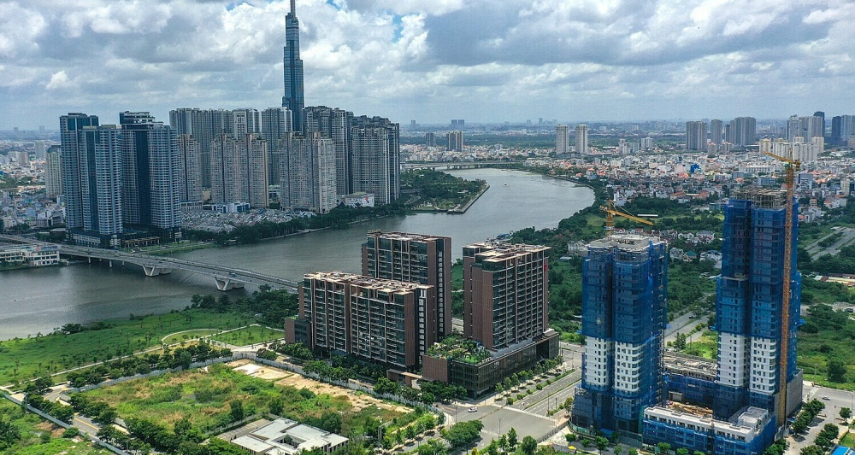The expansion of Ho Chi Minh City’s administrative boundaries has raised high expectations about shifts in the real estate market, especially regarding housing prices. Many investors and homebuyers hoped that housing prices in HCMC after the merger would decrease, particularly in areas with lower property prices such as Binh Duong and Ba Ria–Vung Tau. However, actual market data shows that HCMC apartment prices after the merger have remained stable, even trending slightly upward in many districts.
This article provides an in-depth analysis of current housing supply, land costs, planning and legal frameworks, as well as housing price trends in HCMC after the merger in 2025. At the end, we also include an FAQ section addressing common questions about the real estate market following the merger.

1. Impact of HCMC’s administrative boundary merger on the real estate market
The incorporation of surrounding provinces and cities into HCMC, as part of the administrative expansion, is a major event directly affecting the real estate market. Newly merged areas generally have significantly lower housing prices compared to the old HCMC core, pulling down the overall average price when calculated across the broader city.
However, prices in individual projects and specific areas remain unchanged or have increased due to internal factors such as real demand, infrastructure connectivity, and population characteristics—rather than the administrative changes themselves.
2. Current housing supply in Ho Chi Minh City
2.1 Apartment supply situation
According to Savills and the Ho Chi Minh City Real Estate Association (HoREA), the city set a target of developing 235,000 apartments during 2021–2025. To date, only about 24% has been achieved, equivalent to 56,000 units—a modest number compared to actual demand.
In Q2 2025, new supply increased 38% year-on-year but still amounted to fewer than 2,000 apartments. For the first half of 2025, only a little over 6,000 primary units were launched citywide—far below the housing needs, particularly in densely populated areas with strong infrastructure.

2.2 Limited supply driving prices higher
The shortage of supply has disrupted the balance between demand and availability, putting upward pressure on prices. The market is witnessing a scarcity of apartments priced under VND 40 million/m² in the old HCMC districts, while the average primary apartment price has reached nearly VND 90 million/m².
Most current commercial housing projects are in the high-end segment, failing to meet demand for affordable or mid-range housing—making it difficult for budget-conscious buyers to access suitable products.
3. Land costs and their influence on housing prices after the merger
3.1 Current land price framework has not decreased
According to Ms. Cao Thi Thanh Huong, Senior Manager of Savills Vietnam Research, the government-regulated land price framework has not been adjusted downward despite the administrative merger. Reviews and updates to the framework are still under study, with no definitive results yet.
3.2 Input costs unchanged, making price reductions unlikely
With land costs remaining high and construction and labor expenses staying stable or rising, housing prices are unlikely to decline. Therefore, the impact of the administrative merger on housing prices is minimal in the short term, and could even create conditions for further price increases.
4. Planning and legal framework – Key factors in HCMC housing prices after the merger
4.1 Reviewing and adjusting urban planning
After the merger, the old planning system must be reviewed and adjusted to suit the new HCMC, especially in reallocating residential, industrial, and agricultural land. This will directly affect the land price framework and real estate development strategies in the coming years.
4.2 Impact of the Land Law, Real Estate Business Law, and Housing Law
Legal frameworks play a critical role in ensuring market transparency, boosting supply, streamlining project administration, and shortening approval processes.
Currently, lengthy and complicated procedures have discouraged developers from launching new projects, further restricting supply and sustaining high housing prices.

4.3 Administrative and licensing reforms
Simplifying project licensing procedures will help increase housing supply, particularly affordable housing, thereby stabilizing prices in the medium term.
5. Housing price trends in HCMC after the merger in 2025 and market expectations
5.1 Market driven by real supply and demand
Ms. Huong emphasized that real demand, infrastructure systems, land costs, and new supply will determine the apartment price levels in 2025. At present, expectations of falling housing prices in HCMC after the merger have not materialized. Prices may remain stable or rise slightly depending on the location and project.
5.2 The key role of interest rates and credit
Real estate lending rates are projected to remain stable in the second half of 2025, creating favorable conditions for homebuyers to access loans. This also gives developers more confidence to implement projects and adopt suitable sales policies.

5.3 Outlook for stable and sustainable growth
For HCMC’s real estate market to achieve stable, sustainable growth, a balanced supply-demand relationship, credit control, and transparent legal frameworks are essential. The administrative merger opens up medium- and long-term development opportunities, but in the short term it has not caused major price shifts.
6. Frequently Asked Questions (FAQ)
-
- Will housing prices drop after HCMC’s merger?
Current surveys indicate that housing prices in old HCMC districts and existing projects remain stable or have slightly increased. While the broader average price declines when including new lower-priced areas, there has been no significant price reduction at the project level.
-
- What is the current housing supply in HCMC?
HCMC is short of about 179,000 units compared to its 2021–2025 target. In the first half of 2025, only about 6,000 primary units were launched. The limited supply is one of the key reasons keeping housing prices high.
-
- How does urban planning affect housing prices?
Regional planning, land allocation (residential, industrial, agricultural), and approval processes directly impact land prices and the feasibility of new projects, which in turn affect housing prices.
-
- What are the most important factors influencing HCMC apartment prices?
Land costs, housing supply, planning processes, legal frameworks, administrative procedures, and mortgage interest rates are the key factors determining housing prices.
You may be interested in:
-
- Amendment to the 2024 land law: Unblocking financial bottlenecks, ending the practice of “citizens buying their own land”
- Ho Chi Minh City invests 7 billion USD to develop international financial center
- Surprising Benefits of Owning Social Housing That You Might Not Know
- Top southern regions forecasted for strong growth in Vietnam’s real estate market in 2025
- Amendment to the 2024 land law: Unblocking financial bottlenecks, ending the practice of “citizens buying their own land”




